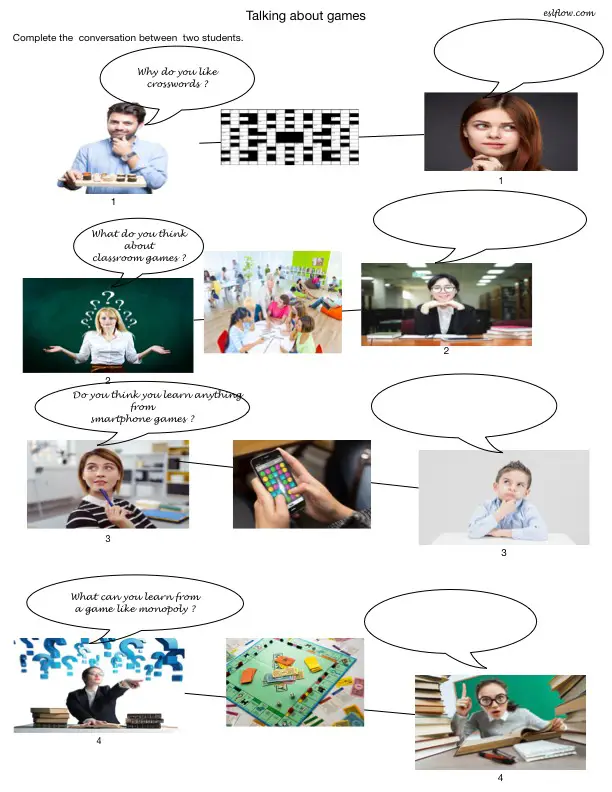Tenses practice worksheet 3 This worksheet aims to help students understand the different tenses, particularly the perfect and continuous tenses. Click on the image below or the link at the side to download the PDF file.
Tenses practice with timelines 1 (PDF)
Eternal Mingle: a first meeting icebreaker activity
Eternal Mingle
INTRO
This is an excellent all-purpose communicative activity for big ESL classes. It’s effective because it just about ensures a high level of student participation. It also lowers inhibition levels, encourages student centered correction and frees the teacher to observe and field questions from students. The possible variations are endless. It can be used as an icebreaker, for drills, or as an iniator of free conversation.
STEP 1
Hand out a slip of paper to each student.
STEP 2
Delegate a word, phrase, a question beginning, a concept, a topic, or a a grammar component to each student. This depends on your lesson focus. Explain to the students that they are to write a sentence or question including the word, phrase etc.To take this step further you can also tell the students to write an answer/response to their own question/sentence on the BACK of theslip of paper
STEP 3
Model an interaction with a student. Supposing you are practicing questions, ask a student your question then listen to the response and reply if necessary. Then get the student to ask you his/her question. After the exchange switch papers and randomly choose a new partner for a new exchange. Because you are “eternally” switching papers and partners the exercise is
“endless”. (I’ve often had talkative classes take the exercise and run with it for an hour or so… totally oblivious to the teacher’s
presence).
EXAMPLES OF VARIATIONS
TEACHING PRESENT SIMPLE (Questions)
Delegate question beginnings such as What do…? Where does…? Why do..? Do you…? Does …….? Why don’t you..? Is
there….? Are we….? Is today……? etc.
TEACHING MODALS (Questions)
Why must….? Where do you have to…? Do you need to ….? What should you….? Why mustn’t……? Should people…?
etc.
TEACHING “WISH” (SENTENCES)
Tell everryone to write a wish on the front of the paper and a reason on the for their wish on the BACK. So when the students
talk Student A might say ” I wish I had a car” and Student B could ask “Why don’t you have a car?” or “Why do you wish
you had a car?”
DRILL FOR INDIRECT REQUESTS
Delegate the 3 most commonly used verbs for requests( to be, to do and modals) around the class. Say to the first student “verb to be”, to the second student “verb to do”, to the third student “modal”, to the fourth student “veb to be”, to the fifth student “verb to do” and so on. The students must then write a direct question using their verb type on the FRONT of the slip
of paper and the indirect conversion of that question on the BACK of the paper. The students can then walk around reading direct questions and getting their partners to respond with the indirect question.
Tenses practice worksheet using timelines & pictures with answers (PDF)
Circle the correct part of speech for suffixes- -able -ity(PDF)
Describing-companies—their-activities
Popular Resources
Describing companies: what do companies do?
This is an elementary business English ESL exercise exploring the language and vocabulary for descrbing the activities of companies. First, students write short sentences using the vocabulary below the pictures or their own ideas. On the second page, they complete or fill in apprpriate words under the pictures. Finally, students write and ask each other questions . This exercise focuses on words such as manufacture, produce, design, create, develop and produce. Click on the image below or the link to download the printable PDF file.
Speaking activity about breaking things (PDF)
Popular Resources
Breaking things worksheet
This is an English language exercise for students to try to talk about. breaking thngs Students try to match the vocabulary at the bottom of the page to the pictures. Then they try to answer the questions. Click on the image below or the link to download the printable PDF file.
Talking about humor questionnaire (PDF)
Popular Resources
Talking about humor
This is an ESL discusssion exercise useful for talking about humor. Click on the image below or the link at the right.to download the printable PDF file.
Talking about games questionnaire (PDF)
Talking about games
This is an ESL speaking and discussion exercise for practicing language useful for talking about puzzles and games.
Business English Speaking Skill Worksheets
Other resources
5 Cool Advertising & Branding Vocabulary & Language Exercises
10 Jobs and Careers Vocabulary and Speaking exercises
4 Money and Finance Worksheets
10 Computing and Internet Vocabulary and Speaking Activities
5 Intercultural Body Language, Gestures and Etiquette Language Exercises
